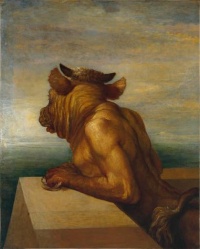Therianthropy
From The Art and Popular Culture Encyclopedia
| Revision as of 11:42, 24 September 2012 Jahsonic (Talk | contribs) ← Previous diff |
Revision as of 22:22, 12 December 2012 Jahsonic (Talk | contribs) Next diff → |
||
| Line 16: | Line 16: | ||
| == Psychiatry == | == Psychiatry == | ||
| Among a sampled set of psychiatric patients, the belief of being part animal, or ''[[clinical lycanthropy]]'', was generally associated with severe psychosis, but not always with any specific psychiatric diagnosis or neurological findings. Others regard clinical lycanthropy as a delusion in the sense of the self-identity disorder found in affective and schizophrenic disorders, or as a symptom of other psychiatric disorders.. | Among a sampled set of psychiatric patients, the belief of being part animal, or ''[[clinical lycanthropy]]'', was generally associated with severe psychosis, but not always with any specific psychiatric diagnosis or neurological findings. Others regard clinical lycanthropy as a delusion in the sense of the self-identity disorder found in affective and schizophrenic disorders, or as a symptom of other psychiatric disorders.. | ||
| - | |||
| - | == References in popular culture == | ||
| - | ===In fiction=== | ||
| - | ''A Practical Guide to Monsters'', a [[Dungeons and Dragons]] themed book published under [[Wizards of the Coast]]'s juvenile publishing imprint [[Mirrorstone Books]], makes reference on page 33 to D&D's use of the term lycanthrope to refer to many different types of humanoid/animal shapeshifters. The text goes on to state that "A better term for this group would be 'therianthrope,' from the root therios (animal)." | ||
| - | |||
| - | ===Internet subculture=== | ||
| - | The first widely-known internet use of the term developed among the [[Usenet]] group ''alt.horror.werewolves'' (ca. 1992). Some Usenet users began publicly asserting that they were part | ||
| - | animal, generally in a spiritual sense. Such people initially called themselves ''lycanthropes'', but because that word specifically means wolf-people the term ''therianthropes'' became more popular. From these foundations, a subculture of individuals identifying as ''therianthropes'' has developed. Some self-described ''therianthropes'' also consider themselves members of the [[Otherkin]] subculture. | ||
| == See also == | == See also == | ||
| - | * [[Clinical Lycanthropy]] | + | * [[Clinical lycanthropy]] |
| * [[List of shapeshifters in myth and fiction]] | * [[List of shapeshifters in myth and fiction]] | ||
| * [[Were]] | * [[Were]] | ||
Revision as of 22:22, 12 December 2012
|
Related e |
|
Featured: |
Therianthropy (from n. therianthrope and adj. therianthropic, part man and part beast, from the Greek therion, θηρίον, meaning "wild animal" or "beast", and anthrōpos, άνθρωπος, meaning "man") refers to the metamorphosis of humans into other animals. Therianthropes have long existed in mythology, appearing in ancient cave drawings such as the Sorcerer at Les Trois Frères.
The term therianthropy was used to refer to animal transformation folklore of Asia and Europe as early as 1901. Therianthropy was also used to describe spiritual belief in animal transformation in 1915 and one source raises the possibility the term may have been used in the 16th century in criminal trials of suspected werewolves.
Contents |
Examples
Ethnologist Ivar Lissner theorized that cave paintings of beings with human and nonhuman animal features were not physical representations of mythical shapeshifters, but were instead attempts to depict shamans in the process of acquiring the mental and spiritual attributes of various beasts. Religious historian Mircea Eliade has observed that beliefs regarding animal identity and transformation into animals are widespread.
Therianthropy can also refer to artistic descriptions of characters that simultaneously share human and nonhuman animal traits, for example the animal-headed humanoid forms of gods depicted in Egyptian mythology (such as Ra, Sobek, Anubis, and others) as well as creatures like centaurs and mermaids.
Some common forms of therianthropy have their own terminologies. Of these, lycanthropy, cynanthropy, and ailuranthropy are the best known. The term "cynanthropy" was applied in 1901 to Chinese myths about humans turning into dogs, dogs becoming people, and sexual relations between humans and canines.
Lycanthropy
In folklore, mythology and anthropology, the most commonly known form of therianthropy is lycanthropy (from the Greek words lycos ("wolf") and anthropos ("man")). Although the definition specifically describes a metamorphic change from human to canine form (as with a werewolf), the term is often used to refer to any human to nonhuman animal transformation.
Psychiatry
Among a sampled set of psychiatric patients, the belief of being part animal, or clinical lycanthropy, was generally associated with severe psychosis, but not always with any specific psychiatric diagnosis or neurological findings. Others regard clinical lycanthropy as a delusion in the sense of the self-identity disorder found in affective and schizophrenic disorders, or as a symptom of other psychiatric disorders..
See also
- Clinical lycanthropy
- List of shapeshifters in myth and fiction
- Were
- Werecat
- Otherkin
- Totem
- Nagual
- Theriocephaly
- Morphological freedom
- Lycanthropy
- The Island of Doctor Moreau
- Parahuman
- Bestiary
- Legendary creature
- Stem cell controversy


